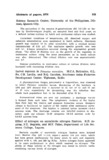Larval mycosis in Penaeus monodon
Share
Abstract
A phycomycetous fungus, presumably a Lagenidium, was observed to infect Penaeus monodon larvae. Monitoring of the hatchery in 1976 and 1977 showed that it occurred in 35 out of 51 and 22 out of 37 runs, respectively. So devastating was the infection that whole tank populations had to be discarded after 48 hr.
Extramatrical tubes are sent out profusely; a discharge vesicle is formed from each tube. The cytoplasmic contents of the hypha then flow into the vesicle, and zoospore formation occurs. Zoospore release is facilitated by rupture of the vesicle after continuous movement of the zoospores. The hyphae in infected larvae measure 2.5-6.3 microns wide. The discharge vesicles are 14.5-25.0 microns in diameter; each one releases 14-32 zoospores 3.8-6.3 microns wide by 5.0-6.3 microns long.
Description
Abstract only.
Suggested Citation
Baticados, M. C. L., Po, G. L., Lavilla, C. R., & Gacutan, R. Q. (1979). Larval mycosis in Penaeus monodon. Kalikasan: The Philippine Journal of Biology , 7(3), 329. http://hdl.handle.net/10862/1017
Collections
- AQD Journal Articles [1249]

